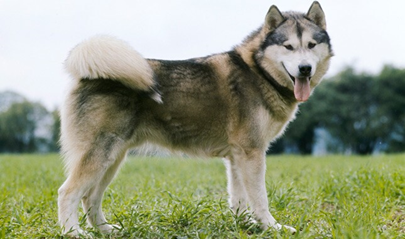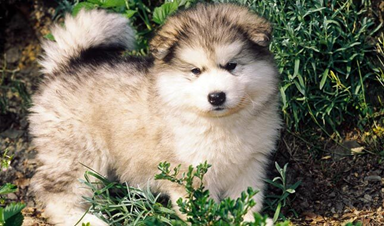
Standing at 23 to 25 inches at the shoulder, with weights of 75 to 85 pounds, Alaskan Malamutes are immensely strong, heavy-duty worker of spitz type. Originally bred to pull sleds in harsh terrain and brutal climates, these very solid dogs are however popular due to their looks and individual personalities. Often mistaken for Huskies, the Malamutes are larger and known for being affectionate, loyal, and playful. They are recognizable by th e well-furred plumed tail carried over the back, erect ears, and substantial bone.
With the fact that the Alaskan Malamute is a big, powerful dog, they are also expert diggers and climbers- which makes keeping them behind the fence extremely difficult. Keeping them in the backyard isn’t a great idea unless you like holes the size of a swimming pool, and your neighbors like howling. It will not be a surprise to not find your malamute when you get home, since he considers fences to be interesting challenges rather than genuine obstacles.
However, the destructiveness of your Malamute can be prevented with lots of exercises. Taking them to hiking, pulling sleds in winter and carts in summer, competitive weight pulling and formal obedience are can be good for his brain and his brawn. The Malamutes are also smart and curious. Mals don’t bark a lot, but they are very vocal and has the tendency to howl. They love to run, pull, and roam. Despite being sociable towards people, it can be aggressive toward strange dogs or animals. Training from a young age is recommended.
Despite being relatively healthy breed with an average lifespan of 12 years, they can suffer from some common conditions like hip dysplasia, hypothyroidism, and bloat. This breed is also susceptible to bacterial and viral infections, such as parvo, rabies, and distemper, but many of these infections are preventable through vaccination.

Relative to their breed, Malamutes can develop some health conditions to include:
Hip dysplasia – A condition where hip joint doesn’t fit together perfectly, which will eventually lead to arthritis. This is a particularly devastating condition for an active running dog like the Malamute; and it requires costly surgery to correct. Before breeding, dogs should be screened by x-rays through the BVA/Kennel Club Hip Dysplasia Scheme.
Hypothyroidism – This is due to an underactive thyroid, causing problems with weight, skin and energy levels.
Chondrodysplasia – This is a form of dwarfism where cartilage and bone develop incorrectly. The puppies can be screened by x-ray between 5-12 weeks of age.
Idiopathic polyneuropathy – This genetic disorder affects the dog’s nerves which causes chronic lack of coordination and weakness in the dogs. Before breeding, dogs should be screened by blood test to make sure they are not carriers.
Day blindness (also known as haemeralopia or cone degeneration) – This is the sensitivity to bright light which affects their vision. Before breeding, dogs should be screened by blood test to make sure they are not carriers.
Cataracts – These are a common cause of blindness in older Malamutes. There is a ‘clouding’ of the lens of the eye affecting vision. Surgery may be an option to remove cataracts and restore sight. Breeding dogs should be screened every year.
Bloat– The Gastric Dilatation and Volvulus, also known as GDV or Bloat, usually occurs in dogs with deep, narrow chests, making Malamutes more at risk than other breeds. This condition results to stomach twisting- which cuts off blood supply to the stomach, and sometimes the spleen; and thus a quickly fatal disease, sometimes in as little as 30 minutes, if left untreated. Retching or heaving, acting restlessly, laying with front feet down, rear end up, and having enlarged abdomen can be observed. Take your pet to an emergency hospital immediately once symptoms are noticed.
As a puppy, remember to socialize your Mal with lots of other dogs, different people and types of experiences. Taking your Mal, whether a puppy or adult, to a veterinarian soon after adoption is highly recommended to spot visible problems, and also to set up a preventive regimen that will help you avoid many health issues.
References:
https://www.yourpurebredpuppy.com/health/alaskanmalamutes.html
https://animalhealthcenternh.com/client-resources/breed-info/alaskan-malamute/
https://www.akc.org/dog-breeds/alaskan-malamute/
https://vcahospitals.com/know-your-pet/dog-breeds/alaskan-malamute
https://www.embracepetinsurance.com/dog-breeds/alaskan-malamute

